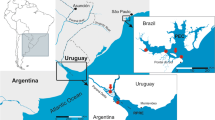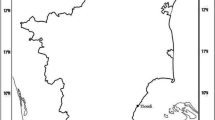Abstract
With the aim of determining arsenic (As) and selenium (Se) concentrations in bycatch fishes from SW Mexico and comparing elemental concentrations with limits for human consumption set in the national and international legislation, three fish species (Diapterus peruvianus, Pseudupeneus grandisquamis, and Trachinotus kennedyi) were collected from Guerrero state during trawling operations. Additionally, As and Se levels in muscle tissue were compared with similar species from diverse areas. The order of As and Se concentrations was T. kennedyi > P. grandisquamis > D. peruvianus. In Mexico, there is no regulation of As and Se levels in fish. In comparison to the legal limit (0.1 μg g−1 wet weight) set by legislation in Venezuela, As levels in the edible portion of T. kennedyi (0.632 μg g−1 wet weight), P. grandisquamis (0.166 μg g−1 wet weight), and D. peruvianus (0.157 μg g−1 wet weight) were above this limit. In the case of Se, average concentrations in T. kennedyi (0.323 μg g−1 wet weight) were above the maximum permissible limit (0.30 μg g−1 wet weight) set in the Chilean legislation. Se concentrations in Carangoides bajad from Saudi Arabia were comparable to values in T. kennedyi (this study). In relation to As, concentrations varied in magnitude orders; the highest As concentration (range 10.35 to 23.71 μg g−1 wet weight) corresponded to Mullus barbatus from the Iberian Mediterranean.

Similar content being viewed by others
References
Allen GR, Bauchot ML, Bellwood DR, Bianchi G (1995a) Peces óseos. In: Fischer W, Krupp F, Schneider W, Sommer C, Carpenter KE, Niem VH (Eds) Guía FAO para la identificación de especies para los fines de la pesca. Pacífico Centro-Oriental, vol. II. Vertebrados-Parte 1. FAO, Roma, pp 647–1200
Allen GR, Bauchot ML, Bellwood DR, Bianchi G (1995b) Peces óseos. In: Fischer W, Krupp F, Schneider W, Sommer C, Carpenter KE, Niem VH (Eds) Guía FAO para la identificación de especies para los fines de la pesca. Pacífico Centro-oriental, vol. II. Vertebrados-Parte 1. FAO, Roma, pp 1201–1813)
Alverson, D. L., Freeberg, M. H., Murawski, S. A., & Pope, J. G. (1994). A global assessment of fisheries bycatch and discards. FAO Fisheries Biological and Technological Papers, 339.
Benedicto, J., Martinez-Gomez, C., Guerrero, J., Jornet, A., & Del Arbol, J. (2007). Heavy metal concentrations in red mullet Mullus barbatus (L. 1758) from the Iberian Peninsula coast (northwestern Mediterranean). Rapport Commission International pour l’exploration scientifique de la Mer Mediterranee, Monaco, 38, 233–2007.
Biddinger, G. R., & Gloss, S. G. (1984). The importance of trophic transfer in the bioaccumulation of chemical contaminants in aquatic ecosystems. Residue Reviews, 9, 104–145.
Bissen, M., & Frimmel, F. H. (2003). Arsenic—a review. Part I: occurrence, toxicity, speciation, and mobility. Acta Hydrochimica et Hydrobiologica, 31, 9–18.
Brigelius-Flohé, R. (1999). Tissue-specific functions of individual glutathione peroxidases. Free Radical Biology and Medicine, 27(9/10), 951–965.
Burger, J., Gochfeld, M., Batang, Z., Alikunhi, N., Al-Jahdali, R., Al-Jebreen, D., Aziz, M. A. M., & Al-Suwailem, A. (2014). Interspecific and locational differences in metal levels in edible fish tissue from Saudi Arabia. Environmental Monitoring and Assessment, 186, 6721–6746.
Conti, G. O., Copat, C., Ledda, C., Fiore, M., Facllico, R., Sciacca, S., & Ferrante, M. (2012). Evaluation of heavy metals and polycyclic aromatic hydrocarbons (PAHs) in Mullus barbatus from Sicily channel and risk-based consumption limits. Bulletin of Environmental Contamination and Toxicology, 88(6), 946–950.
De Gieter, M., Leermakers, M., Van Ryssen, R., Noyen, J., Goeyens, L., & Baeyens, W. (2002). Total and toxic arsenic levels in north sea fish. Archives of Environmental Contamination and Toxicology, 43(4), 406–417.
Eisler, R. (2010). Compendium of trace metals and marine biota volume 2: vertebrates. Amsterdam: Elsevier.
Flores-Rodríguez, P., Flores-Garza, R., García-Ibáñez, S., Valdés-González, A., Violante-González, J., Santiago Cortés, E., Galeana-Rebolledo, L., & Torreblanca-Ramírez, C. (2012). Mollusk species richness on the rocky shores of the state of Guerrero, Mexico, as affected by rains and their geographical distribution. Natural Resources, 3, 248–260.
García, E. (1981). Modificaciones al Sistema de clasificación climática de Köppen. México D.F: Universidad Nacional Autónoma de México.
Giordano, R., Arata, P., Ciaralli, L., Rinaldi, S., Giani, M., Cicero, A. M., & Costantini, S. (1991). Heavy metals in mussels and fish from Italian coastal waters. Marine Pollution Bulletin, 22, 10–14.
Kahn, M., Raml, R., Schmeisser, E., Vallant, B., Francesconi, K. A., & Goessler, W. (2005). Two novel thioarsenosugars in scallops identified with HPLC-ICPMS and HPLC-ESMS. Environment and Chemistry, 2(3), 171–176.
Madrid-Vera, J., Amezcua, F., & Morales-Bojórquez, E. (2007). An assessment approach to estimate biomass of fish communities from bycatch data in a tropical shrimp-trawl fishery. Fisheries Research, 83, 81–89.
Magalhães, M. C., Costa, V., Menezes, G. M., Pinho, M. R., Santos, R. S., & Monteiro, L. R. (2007). Intra- and inter-specific variability in total and methylmercury bioaccumulation by eight marine fish species from the Azores. Marine Pollution Bulletin, 54, 1654–1662.
Mandal, B. K., & Suzuki, K. T. (2002). Arsenic around the world: a review. Talanta, 58, 201–235.
Moody, J. R., & Lindstrom, R. N. (1997). Selection and cleaning of plastic containers for storage of trace element samples. Analytical Chemistry, 49, 2264–2267.
NOM-242-SSA1-2009. Productos de la pesca frescos, refrigerados, congelados y procesados.
Nauen, C. E. (1983). Compilation of legal limits for hazardous substances in fish and fishery products. FAO Fisheries Circular, 764, 1–102.
Nrashant, S., Deepak, K., & Anand, PS. (2007). Arsenic in the environment: Effects on human health and possible prevention. Journal of Environmental Biology, 28(2), 359–365.
Plessi, M., Bertelli, D., & Monzani, A. (2001). Mercury and selenium content in selected seafood. Journal of Food Composition and Analysis, 14, 461–467.
Rábago-Quiroz, C. H., López-Martínez, J., Herrera-Valdivia, E., Nevarez-Martínez, M. O., & Rodríguez-Romero, J. (2008). Population dynamics and spatial distribution of flatfish species en shrimp trawl bycatch in the gulf of California. Hydrobiologia, 18, 193–202.
Rahman, M. A., Hasegawa, H., & Lim, R. P. (2012). Bioaccumulation, biotransformation and trophic transfer of arsenic in the aquatic food chain. Environmental Research, 116, 118–135.
RDA from Food and Nutrition Research Council (1989). Recommended dietary allowance (10th ed., ). Washington, DC: National Academic Press.
RETC. Registro de Emisiones y Transferencias de Contaminantes (2013). http://app1.semarnat.gob.mx/retc Accessed 20 febrero 2015.
Rivas, A., Peña-Rivas, L., Ortega, E., López-Martínez, C., Olea-Serrano, F., & Lorenzo, M. L. (2014). Mineral element contents in commercially valuable fish species in Spain. Scientific World Journal, 2014, 1–7.
Yang, D.-Y., Chen, Y.-W., Gunn, J. M., & Belzile, N. (2008). Selenium and mercury in organisms: interactions and mechanisms. Environmental Reviews, 16, 71–92.
Yarsan, E., Yipel, M., Yipel, F. A., & Dikmen, B. (2014). Accumulation of nonessential potentially toxic trace elements (PTEs) in the some economically important seafood species of Mediterranean. Kafkas Üniversitesi Veteriner Fakültesi Dergisi, 20(2), 185–188.
Acknowledgments
The authors would like to thank Ramírez-Resendiz, G.; Amezcua-Martínez, F.; Vazquez-Melchor, F.; and Osuna-Sánchez K. for their technical assistance and paper revision. This project was funded by the Ministry of Public Education (Project REDES PROMEP/103.5/13/9366), DGEST (project 5353.14-P) and National Council of Science and Technology (Project INFRA 2013).
Author information
Authors and Affiliations
Corresponding author
Ethics declarations
Conflict of interest
The authors declare that they have no competing interests.
Rights and permissions
About this article
Cite this article
Spanopoulos-Zarco, P., Ruelas-Inzunza, J., Jara-Marini, M.E. et al. Bioaccumulation of arsenic and selenium in bycatch fishes Diapterus peruvianus, Pseudupeneus grandisquamis, and Trachinotus kennedyi from shrimp trawling in the continental shelf of Guerrero, México. Environ Monit Assess 187, 700 (2015). https://doi.org/10.1007/s10661-015-4916-5
Received:
Accepted:
Published:
DOI: https://doi.org/10.1007/s10661-015-4916-5




